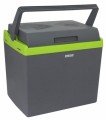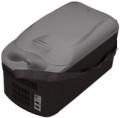Type
—
Refrigerator container. Thermally insulated containers designed for use in cars and as close as possible to ordinary kitchen refrigerators both in functionality and appearance. They look like boxes, most often plastic, can have a rather large volume (40 liters or more), are designed primarily for stationary installation in a car and are usually quite inconvenient to carry (although most models can be easily carried in hands over short distances). Equipped with temperature maintenance systems (up to compressors, see "Functions"), they require external power supply.
—
Cooler bag. Like the containers described above, this type belongs to car accessories, requires external power, is able to provide cooling similar to classic refrigerators, and can also have other modes of operation (see below). Externally, in accordance with the name, such models resemble ordinary bags, often have fabric upholstery, external pockets, and almost always carry handles. They are easy to transport in your hands, which can be useful for loading: it is often more convenient to load the refrigerator in the kitchen and transfer it to the car than to carry the products separately to the car. This design of the refrigerator is also especially convenient for outdoor trips, picnics, etc. On the other hand, bags usually have a small volume (not exceeding 40 liters).
— Embedded. As the name implies, this variety is desig
...ned for permanent installation in vehicles. Its main difference from the containers-refrigerators described above is its poor suitability for carrying from place to place, in addition, such devices can have quite large volumes. Due to their large size, most built-in refrigerators are not well suited for passenger cars, where there is usually little space — but they can be very useful for buses, tractors, motorhomes, and even boats and yachts. Some of these models are originally made for a specific brand of car.
— Refrigerator-armrest. A specific type of refrigerator-containers (see the relevant paragraph). The main difference of this variety from the "ordinary" containers is just the possibility of installation as an armrest. At the same time, installation methods can be different: some models are placed in the centre of the rear seat and are fixed with a seat belt, others can also be installed between the front seats. The main advantage of such units can be called the fact that they create a minimum of discomfort, and often vice versa — they provide additional convenience, playing the role of the actual armrest. In addition, coasters and other additional devices can be provided on the case. However, before buying, you should make sure that the selected model is suitable for your car in shape and dimensions. Also note that the volume of refrigerators of this type is relatively small — usually less than 25 liters.Volume
The volume of the working chamber of the car refrigerator. The larger the volume, the more products can be loaded into the unit at a time. When choosing according to this parameter, it makes sense to select a model with a margin, because it is not recommended to load products too tightly — this adversely affects the quality of the device. On the other hand, note that the volumetric container and dimensions will have the appropriate ones.
Number of chambers
The presence in the refrigerator of separate zones for storing products, separated by a stationary dense wall of a non-removable structure. The vast majority of car refrigerators have a
single-chamber layout, however, there are also
two-chamber models, which is extremely convenient for sorting products.
Max. cooling at
This parameter determines how many degrees the refrigerator is able to cool the product loaded into it relative to the ambient temperature. Let's say the maximum cooling for a particular refrigerator model is 20°C; at an air temperature of +30°C, a product with the same temperature is loaded into it. Thus, the final temperature of the product will be 30 – 20 = +10 °C. In addition, it should be noted that the final temperature cannot be lower than the minimum cooling temperature (see Minimum cooling temperature)
Min. cooling temperature
The minimum temperature to which the refrigerator is able to cool the product placed in it when operating in cooling mode. It should be taken into account that the minimum cooling temperature is not always achievable in fact: the actual cooling temperature depends on the ambient temperature and on the capacity of the refrigerator for maximum cooling (for more details on the calculation formula, see "Maximum cooling per (°C)"). However, this applies only to refrigerators that are not equipped with compressors (see Compressor);
compressor models are able to reach the minimum cooling temperature regardless of external conditions.
Сooling energy consumption
The power consumed by the refrigerator when operating in cooling mode. The greater this power, the more performant the refrigerator is, usually, and the less time it takes to cool the product. On the other hand, note that more power means more power consumption — which can be critical, for example, during long-term operation from a car battery (that is, when the car engine is turned off).
Features
—
USB for charging gadgets. A standard USB port that can be used to charge a smartphone or other gadget. Note that this function only works if the refrigerator is connected to the power grid — car refrigerators do not have their own batteries, and without an external power source, no energy will be supplied to the USB port.
—
Smartphone control. The ability to control the unit from a smartphone or other gadget, usually through a special application. The gadget itself is connected directly wirelessly, via Wi-Fi or Bluetooth. This function provides a number of conveniences. Firstly, it allows you to control the operation of the refrigerator from a distance. Secondly, the application on the smartphone is often more convenient and visual than the unit's own control panel. Thirdly, the gadget can receive various notifications from the refrigerator: settings, current status, notifications about malfunctions, etc. At the same time, control from a smartphone is not cheap, which is why it is quite rare, mainly in fairly advanced models.
—
Built-in fan. The presence of a fan in the working chamber of the refrigerator. Due to this function, improved air circulation inside the chamber is ensured, which contributes to better and more uniform cooling of the loaded products.
—
Battery discharge protection. A car refrigerato
...r with this function constantly monitors the battery condition when operating from a car battery (with the engine off). If the charge drops to a critical level, the unit “takes action”: it switches off automatically or signals the need to switch off. This allows you to avoid a complete battery discharge and unpleasant situations such as the need to start the engine “by pushing”.
— Interior lighting. The presence of internal lighting in the working chamber of the refrigerator. This makes it easier to use in low-light conditions — even in complete darkness outside, the contents of the chamber can be easily seen.
— Cup holder. Cup holders are typical indentations in the lid: a cup, bottle, or another container with liquid can be placed in such an indentation without fear of it tipping over.
— Bottle opener. A tool for opening glass bottles with metal caps that do not have threads. It is usually implemented as a built-in metal element on one side of the housing.
— Removable lid. The ability to remove the refrigerator cover from the main container. The meaning and features of this function may be different. So, in some models, the cover is removed only to make it easier to get to the contents and to make it easier to wash/clean the working chamber. In others, it may be possible to choose the side to which the cover will be folded. And some units with this function are equipped with two lids at once: one has a power cord and a cooler, when installed, the device functions as a refrigerator, the second is a simple heat-insulating cover that turns the car refrigerator into a thermos.
— Carrying strap (on the shoulder). Special strap that allows you to carry the device like shoulder bag. In fact, this function is most often equipped with bag models (see "Type"). In any case, such a strap significantly simplifies transportation: it is more convenient to carry a fairly heavy refrigerator on your shoulder, and your hands remain free. There are even models that can be carried like regular backpacks.
— Transportation wheels. The ability to transport car refrigerators like a cart is much more convenient than carrying them in your hands or on your shoulder, especially with large volumes and the corresponding weight of the model.
